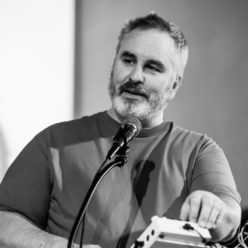My storytelling life was started by a territorial gerbil and a panicked need to explain why I emerged bloodied from the kindergarten bathroom to hide my shame about surrendering to temptation and ignoring the “DO NOT TOUCH THE GERBIL” sign in large and well-articulated handwriting on the gerbil’s enclosure which, for whatever reason, was stationed there. I stepped out of the tiled bathroom, hoping for anonymity even as my hand left a trail of red punctuation marks on the harvest gold carpet, and was immediately intercepted by the classroom aide, Mrs. Hecker, who asked the fearful question.
“Why are you bleeding, Mr. Wall?”
“Umm,” I said, a whole engine room of newly installed machinery in my head groaning into action. “I cut my hand on the paper towel thing and — “
“You cut your hand getting a paper towel?”
“Uh, yeah, the towel dispenser was sharp and I slipped because my hands were wet and the floor got wet and I slid and — “ I said, starting to spin an increasingly complex tale of how I’d injured myself that would become a blueprint for future ventures into the glorious world of storytelling, first as an escape from responsibility and then as a realization that in the even-tempered, earth-toned, averaged-out world of elementary school in the seventies, words and how they were chosen and arranged could reshape reality.
“That looks suspiciously like a gerbil bite to me,” Mrs. Hecker said, examining my hand as she applied the sting of an alcohol wipe and applied a plastic bandage, and I was caught, but it was an intoxicating moment of dramatic reconstruction that worked as well for flowery lies and stories that would otherwise be flat exposition without the right pacing, pauses, and perfect adjectives.
I was a flamboyant liar as a child — a thorough and sometimes credible raconteur of alternate explanations for my ventures in stupidity — and oddly, that’s a great start for telling true stories down the line. To get away with one’s most lurid half-truths, one had to master memory, so that a story stayed consistent from listener to listener, and drama, so that you had enough time and attention to properly tease out the details that made the whole thing work.
In retrospect, it was all part of an internal effort to make sense of a world that always seemed so much duller than what seemed fair. We were born, we were alive, and life should have been about shaking the stars out of the skies, but more often, it was just feeding the chickens and taking out the kitchen compost and diagramming sentences, and my grandmother aided and abetted my escape from the mundane with her own stories and the electric moment when, apropos of nothing, she leaned into me with a menthol-scented Baltimore whisper in 1978.
“Joe-B,” she said, “Did I ever tell you I’m part Indian princess from outer space?”
In adulthood, the process of learning to tell my stories was more of a wandering path through the incoherent landscape of uncontrolled rambling to my overscripted and often overwrought attempts to be a latter-day Laurie Anderson in the early nineties, complete with a stage full of squabbling synthesizers failing to respond to their orders, which taught me how to improvise and vamp until the goddamn thing rebooted mid-story. These days, my focus is on shifting down from my comfortable 60–90 minute one-man-show format, which is probably my most natural unit of storytelling granularity, to the 20–30 minute festival narratives I perform while accompanying them with a tiny synthesizer rig that I jokingly call my “banjo” as an homage to the folk troubadour tradition, and scaling away from sprawling epics to work in the customary 7-to-15-minute story format that’s finally giving me access to ensemble storytelling shows.
My best learning moment, though, was figuring out that there’s a natural storytelling rhythm and pace that’s inherent to each of us and to the kinds of stories we tell, and that when you master the structure, it becomes easier and easier to populate the details on the fly in ways that suit your own narrative. I used to script and soundtrack in minute detail, which made for a great feeling of initial control, an anxious performance as a seemingly endless series of cues I’m afraid of missing, and a sense of disappointment at the end that I’d failed to execute the story with aplomb and humor…but now I basically work and rework, write up a 3×5 index card of keywords that highlight waypoints on the trail to the end of the story (which I keep on hand for reference, but never seem to use in performance, as the process of writing that out and recopying it as I work through a given story tends to install it in my head), and step out into the lights on a stage with a history of mostly getting it right.
In the end, the joy of a story is similar to what it was when I was very young, when I found that words make reality, even when the reality I was making was often divergent from the tale as it actually unfolded, and there’s a nice middle-ground between the comforting structure of just repeating your story from a mental script and the ego-affirming delight of stepping off the stage into the attention of the audience and being carried by their enthusiasm, and it’s something that most people can do after a moment of being foolhardy, ignoring the “DO NOT TOUCH THE GERBIL” sign in large and well-articulated handwriting, lifting the lid to the caged stories we all keep, and cornering a rodent that does not want to be held.
It’s going to hurt, but it gets easier.
